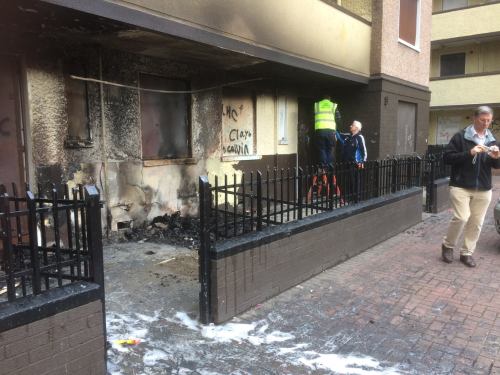In January 2012, we had the privilege of sitting down and chatting with Terry Fagan, the driving force behind the North Inner-City Folklore Project. The Project has been responsible for a number of oral history publications, most recently a study of Dublin tenement life. The project have also put up several plaques in the north inner-city in recent years, marking the valuable contribution of the area to the struggle for independence.
Quite frankly, what Terry and the NICFP have gathered over time is one of the most important collections of artifacts of working class life and struggle on the island of Ireland. For several years now, the material has been kept in a vacant flat at St. Mary’s Mansions on Railway Street. In recent days, the collection had a very lucky escape:

(Image Credit: Terry Fagan)

(Image Credit: Terry Fagan)
Terry notes that:
The residents of St Marys Mansions of Railway Street including local teenagers have watched over it for nearly two years to make sure nothing happened to it as it lay in the boarded up Dublin City Council flat. Only for the Council over the many years they have always helped me with a place to store the archive which keeps on growing as more artifacts are giving to me by some local people. The flat complex is not being pulled down, it is to be redesigned with the start of the art housing is to be in place for the residents when the return after moving out temporally.
The Halloween event is not too far away and the young children were out and about collecting all sorts of wood for the Halloween bonfire, they had it stored near where the archive is housed on the ground floor flat. They would tell me as I was going in and of the flat “We will make sure nothing will happen to it.”
I had them all in looking at the old black and white photographs, and some were pointing out their grandmothers and grandfathers. They were amazed looking at the old tenement artifacts; old gas lamps and oil lamps old valve radios, the old money and artifacts I found in the underground tunnels of what was old Monto.
During the night a group from another part of the area came in and set fire to the wood they had spent days collecting in preparation for Halloween. Thanks to Dublin Fire Brigade who where on the scene quickly and put out the fire which almost spread next-door to where the archive is housed. I don’t think they knew was stored next door to where the fire was, but they saved the history of the area. I thank them.
While there was “some smoke damage to some of the large photographs inside the flat”, the collection of the NICFP has survived and is being moved to a new location. These items certainly deserve to be on view to the public in the future, and we wish Terry and all his team the greatest success in their endeavors to create a local museum site.

(Image Credit: Terry Fagan)

(Image Credit: Terry Fagan)

 Click on the book for more.
Click on the book for more. Click on the book for more.
Click on the book for more.
Would love to know more about the tunnels he mentions in old Monto – anyone have any info, please?
A distant relative of mine, the noted lighthouse builder George Halpin (1779 – 1854), owned a good deal of land on Railway Street (or what was then called Mecklenburgh Street) in the early 1800s, and together with his brother Richard built many of the houses that once stood there. The occupants of those homes were members of the aristocracy and gentry, so it’s not inconceivable that the tunnels underneath were installed as a safe place to retreat to in the event of another rebellion, and a route out of the area should the need arise. Upwards of 30,000 people had been killed in 1797/98, leaving Irish Protestants in fear of being massacred. Since the tunnels couldn’t have been built without their money, it’s probably safe to assume that they had something to do with their construction.
I’m only speculating here, so don’t treat what I’ve said as gospel. Hopefully others respondents can clarify the matter further.
By diligently collecting the memories and personal memorabilia of Dublin’s poor, Terry has performed an invaluable service to the people of the North inner city area, and more broadly to the people of Ireland. I’m relieved to hear his archive was saved, and I hope Dublin City Council reacts to the mishap by providing Terry with adequate facilities to store his archive safely and to continue with his vital work. Maybe the Writer’s Center in Parnell Square, or the Joyce Centre in North Great George’s Street, could assist him in a material way with a joint venture. At any rate, I’m sure I’m not alone in wishing Terry the best.
Reblogged this on Oconnellpadd13's Blog.